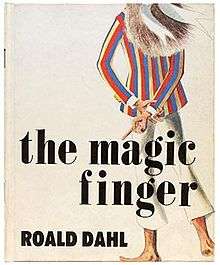The Magic Finger
The Magic Finger is a fantasy story written by Roald Dahl in 1962.[3][4] It was first published in the United States, by Harper & Row in 1966, as a picture book illustrated by William Pène du Bois.[1][5] Allen & Unwin published a Pène du Bois edition in the U.K. in 1968.[2] Later editions have been illustrated by Pat Marriott, Tony Ross, and Quentin Blake.[5] The novel was adapted into a 1990 TV special.[6]
 First British edition (Allen & Unwin, 1968) | |
| Author | Roald Dahl |
|---|---|
| Illustrator | William Pène du Bois (first), Pat Marriott, Tony Ross, Quentin Blake |
| Cover artist | Pène du Bois (first), Marriott, Ross, Blake |
| Country | United States |
| Subject | Hunting, magic[1] |
| Genre | Children's picture book, fantasy |
| Publisher | Harper & Row (first), George Allen & Unwin (first UK)[2] |
Publication date | 1966 |
| Media type | Print (hardcover) |
| Pages | 40 |
| LC Class | PZ7.D1515 Mag[1] |
Synopsis
The Magic Finger is narrated by an eight-year-old girl (voiced by Anne Clements in the United Kingdom) growing up on a farm in the English countryside, next door to the Gregg family who have a passion for hunting. The titular "Magic Finger" is an ability she has that activates inadvertently whenever she gets intensely angry: the finger shoots out a beam of energy that apparently seeks out whoever has angered the girl, with unpredictable consequences.
One day, the girl sees Mr. Gregg and his two sons returning home from a hunt with a deer they have killed, and they make fun of her when she admonishes them. In a rage, she puts the Magic Finger on the entire family: they wake up the following morning to find that they have shrunk to the size of birds and developed wings in place of their arms. While trying their wings, the Greggs fly out of their house, which is promptly occupied by a family of human-sized ducks with human hands, and they are forced to make a nest in an old tree for the night.
The following morning, the Greggs find that, in a major reversal of their habits, the ducks are holding hunting guns on them. Desperately, Mr. and Mrs. Gregg plead with the ducks not to shoot them, but when one of the ducks taunts them about their own fondness for shooting, Mr. Gregg promises to give up shooting and destroy his guns, swearing never to hurt another animal again: the ducks let them leave, and the Greggs find themselves returned to normal.
The girl comes by the farm to see that the Gregg family (now changing their surname to Egg) have fully changed their ways and are now feeding and caring for the birds. As they tell her their story, the sound of gunfire in the distance attracts the girl's attention, and she feels the Magic Finger charging again. The story ends as the girl runs off towards the sound that she can hear in the distance.
References
- "The magic finger". LC Online Catalog. Library of Congress (lccn.loc.gov). Retrieved 2016-02-13.
-
"The magic finger". WorldCat.org. Retrieved 2016-02-13.
One library catalogue record for the 1974 Puffin Books edition. "Originally published: / with illustrations by William Pène du Bois. New York : Harper and Row, 1966 ; London : Allen and Unwin, 1968." - "The Magic Finger". Roald Dahl (roalddahl.com). Retrieved 2015-10-01.
-
"The Magic Finger". Stories: 1960s. Roald Dahl. Retrieved 2016-02-11.
"The Girl". Characters: Children. Roald Dahl. Retrieved 2016-02-11. - The Magic Finger title listing at the Internet Speculative Fiction Database. Retrieved 2016-02-13. Select a title to see its linked publication history and general information. Select a particular edition (title) for more data at that level, such as a front cover image or linked contents.
- https://www.imdb.com/title/tt8112524/